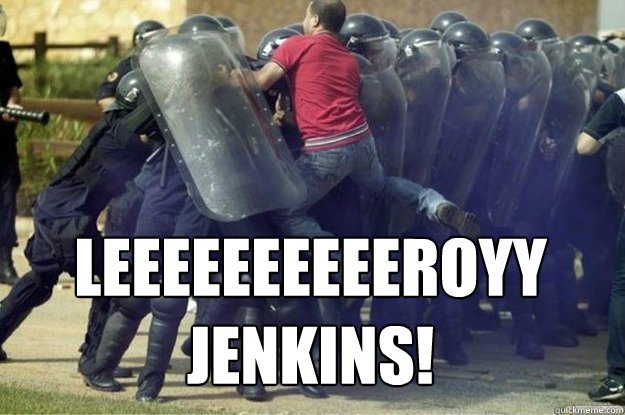Another intense semester has come to an end and suddenly I have some time to relax, to catch up with friends, and even to indulge in wasting a little time on the Internet. Just now I remembered old Leeroy Jenkins — the disruptive antihero of World of Warcraft — and I thought I’d watch the Youtube video of his performance from ten years ago.
Because of my predisposition to see WoW as an unforgivable waste of time, I’ve always loved Leeroy’s utter disregard for the norms, processes, and careful strategic planning of his WoW teammates. Unilaterally cutting the collective planning stage short, Leeroy enthusiastically runs headlong kamikaze-style into enemy territory, embarking on what is sure to be a suicide mission, while narcissistically shouting his own name, “LEEEEEROOOYY JEENNNKINNNSS!!!” With the action kicked off prematurely, his teammates have no choice but to follow Leeroy into the field to do battle with beasts and demons and who-knows-what-else, hoping against hope to salvage something from the unfavorable situation created by the asinine antics of their stupid/brave comrade.
This time watching the clip, I realized how tragically perfect Leeroy Jenkins fits as a metaphor for way too many of my experiences in grassroots social movements. From the global justice movement to Occupy Wall Street (*not these movements as a whole, but particular episodes therein) to countless local campaigns over the past two decades, I have spent so much time and energy running headlong into an asymmetrical battle terrain prematurely — because a few ‘heroes’ self-righteously interpreted the imperative to act as an excuse for neglecting to develop a strategic plan. And once the action is underway, others follow, of course — in order to protect their comrades, to bail them out of jail, to fundraise for their legal defense, and on and on; essentially doing ‘damage control.’ (To be clear, I am not at all suggesting that everyone who gets arrested at street actions is akin to Leeroy Jenkins, or that willingness to endure arrest and repression never serves to further the strategy of a movement.) I have struggled in so many situations like this to try to reframe actions that have already been unfavorably framed by our shit-show first impression.
Yup, I have reluctantly followed Leeroy Jenkins on doomed and costly missions. I can also remember being Leeroy Jenkins at least a few times. Fuckin’ Leeroy Jenkins, screwing it all up. And it just takes one Leeroy Jenkins.









 Next week marks the one-year anniversary of Occupy Wall Street — the movement that took New York’s financial district by storm, rapidly swept across the nation, and dramatically shifted the dominant political discourse. AK Press is releasing their new book
Next week marks the one-year anniversary of Occupy Wall Street — the movement that took New York’s financial district by storm, rapidly swept across the nation, and dramatically shifted the dominant political discourse. AK Press is releasing their new book 
